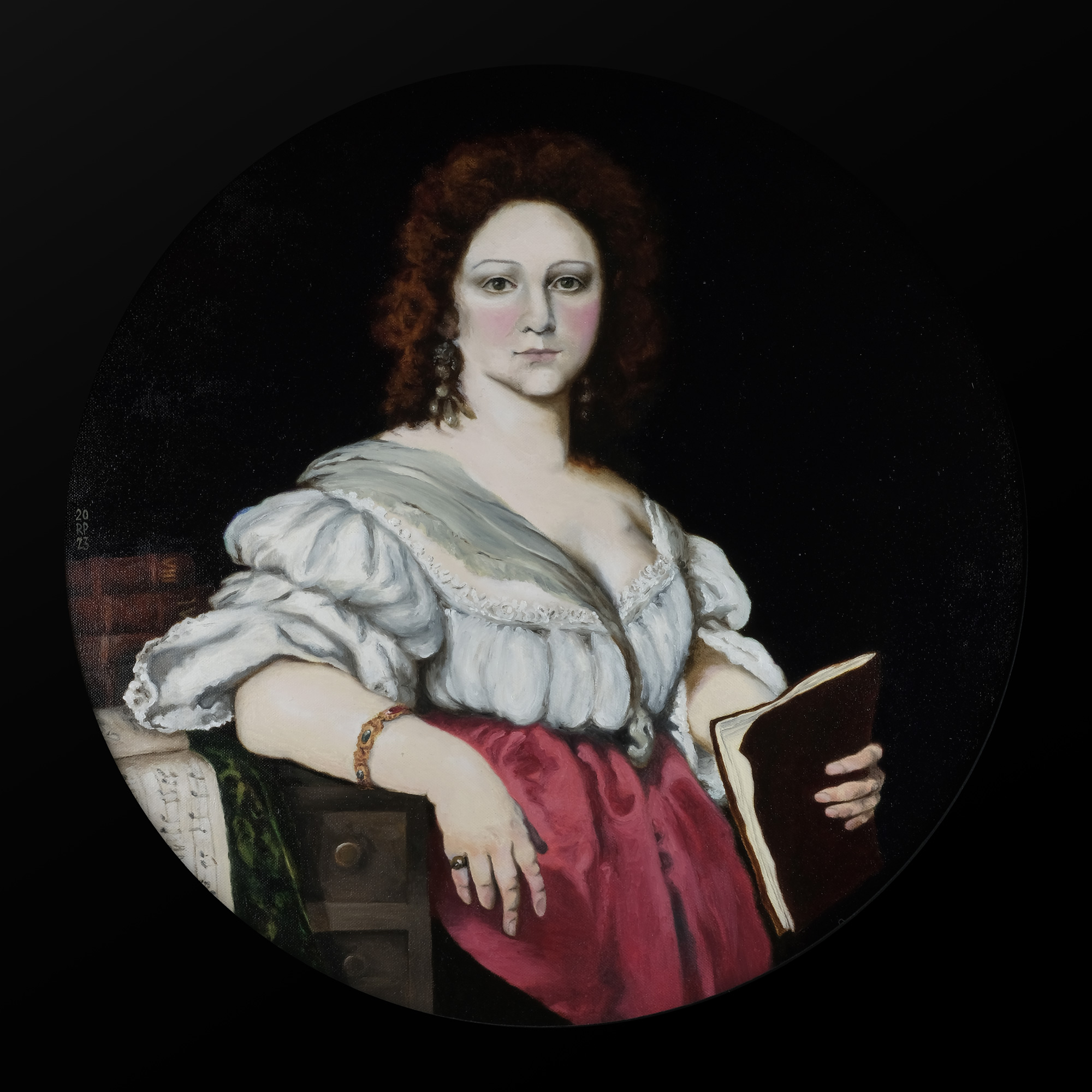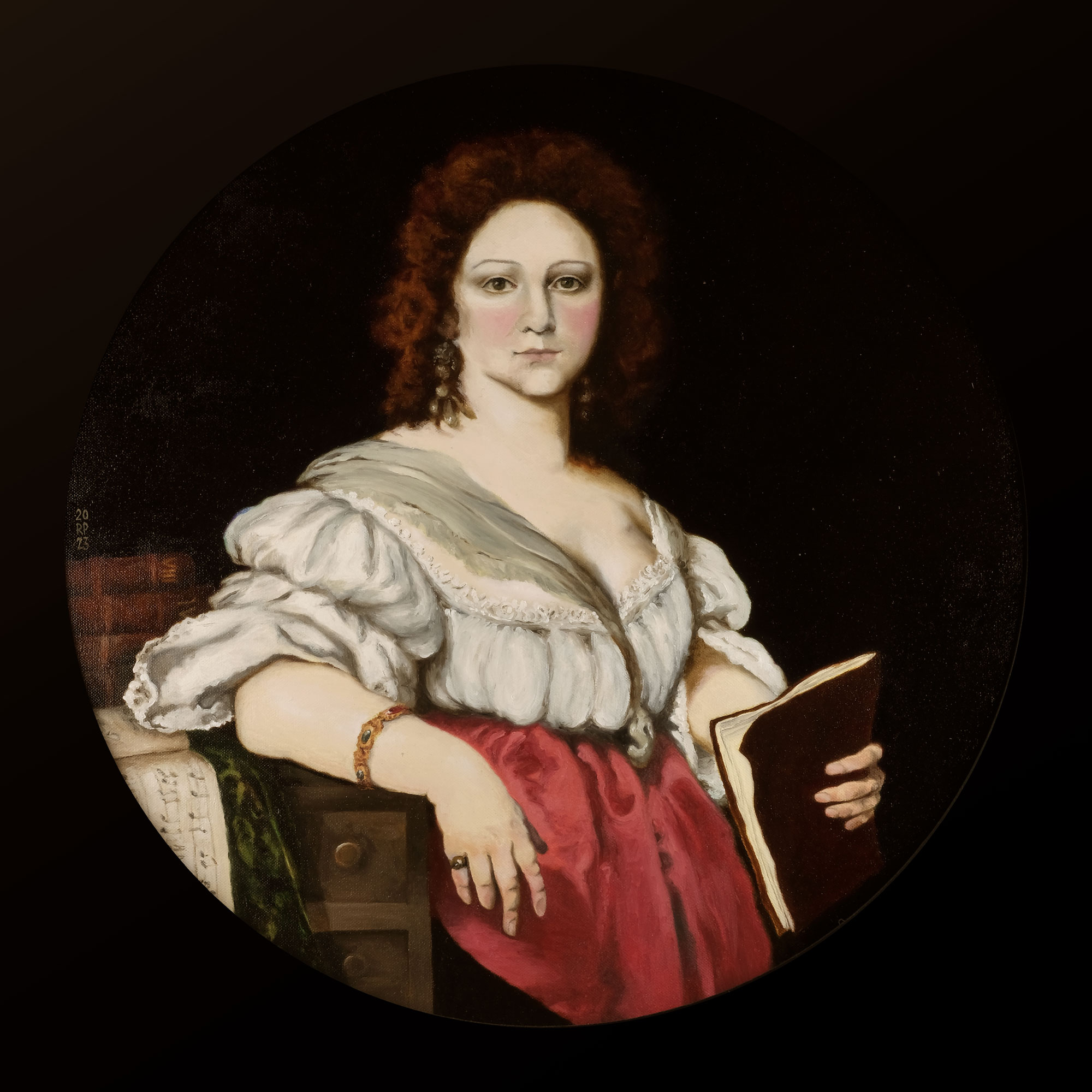
Barbara Strozzi
Composer from Venice
Barbara Strozzi
* 1619 (Venice), † 1677 (Padua)
Barbara Strozzi was born out of wedlock in the liberal Venice of the 17th century. Her adoptive father educated her well and gave her access to the culturally interested Venetian upper class in his salon (“Accademia”).
At the age of 25, in 1644, she began to publish her own compositions. She composed and published for twenty years, but was never employed by the many courts at that time in Northern Italy. Nevertheless, Barbara Strozzi achieved wealth and demonstrated great skill in finance and business.
She left behind an extensive oeuvre of the highest quality, which was appreciated during her lifetime and as such today.
About the Portrait
Representation and Allegory
There is a historical portrait that shows Barbara Strozzi before she appeared with her own compositions (around 1635, almost 10 years before the first publication). This historical portrait shows her with flowers in her hair and bare chest, head bowed and holding the neck of a viola da gamba (today comparable to the cello). This depiction is close to the allegorical representation of the goddess Flora (Vcf. this portrait in the Städel Museum Frankfurt, Germany).
 “The viola da gamba player” by Bernardo Strozzi (no relation to Barbara Strozzi). The sitter has been identified by art historians as Barbara Strozzi. The painting was created around 1635, a few years before Barbara Strozzi began her work as a composer.
“The viola da gamba player” by Bernardo Strozzi (no relation to Barbara Strozzi). The sitter has been identified by art historians as Barbara Strozzi. The painting was created around 1635, a few years before Barbara Strozzi began her work as a composer.
La Strozzi, corrected
I call it a “correction”, even if this may seem somewhat unfair to the painter Bernardo Strozzi, as he painted Barbara Strozzi long before she began her career as a composer. The historical portrait shows her with the attributes of the goddess “Flora” - flowers in her hair, bare breast - and thus suggests that Barbara Strozzi was a courtesan, for which there is no evidence according to current research.
In order to do justice to Barbara Strozzi and her work as a composer, I have made the following changes:
- The head position is straight, looking directly at the viewer
- I replaced the viola da gamba, which she is holding strangely in the original, with a notebook in her hand, the contents of which are anyone's guess.
- On the chest of drawers next to her are now four leather-bound volumes with Roman numerals - a reference to the 8 works she published between 1644-1664.
- On the sheet of music lying next to her, I have noted a different piece, namely one that she composed and that carries a title to comment the wrong perspective the old portrait offers on her: “Havete torto” - “You are wrong”.
- The solid passe-partout with a circular cut-out echoes the design of the portrait of Barbara Strozzi's father to show her at the same height as her father.
Biography
Unmarried and free from convention: Barbara Strozzi takes an unusual path
“The first work that I, as a woman, have so boldly and daringly brought to light.”
these are Barbara Strozzi's words in the preface to her first collection of compositions, Opus I.
Born in 1619 in liberal Venice, presumably as the biological daughter of Giulio Strozzi and his housekeeper. Giulio Strozzi adopted her and provided her with a good education. As a young woman, Barbara performed in her father's salon (“Accademia”) as a chamber singer. Her father Giulio Strozzi was a lover of literature and music and was active as an opera librettist: he wrote the texts for arias.
She is known to have had three children with a friend of her father's from the upper classes, Giovanni Paolo Vidman (born in 1641, 1642 and 1644), but they were not married, which was not unusual in Venice. Her fourth child (born in 1651) probably had a different father.
In 1644, at the age of 25, Barbara began to publish her own compositions. We know from the preface to Opus I that she studied with Francesco Cavalli, the most important composer of her time and himself a pupil of Monteverdi. More than 125 individual works by Barbara Strozzi have come down to us, which the chamber singer and composer published in eight volumes between 1644-1664. Apart from one volume containing sacred compositions, the other collections contain secular vocal music, madrigals, arias and cantatas. She composed more cantatas than any other composer of the 17th century and was a talented networker, as we would describe her today: Unlike most of her contemporaries, she dedicated her works to people outside Venice. And yet she was denied a permanent position as a composer at court for the rest of her life.
Although Venice was very liberal at this time, Barbara Strozzi seems to have had a dubious reputation as a very young chamber singer, as the historical portrait emphasizes, which depicts her in an allegorical representation of Flora as a music lover and enthusiast. There does not appear to be another, later portrait of her. Other contemporaries - such as opera star Anna Renzi or singer and composer Francesca Caccini - were portrayed neutrally during her lifetime. Is it because Barbara Strozzi had no access to a marriage befitting her status, but only to a convent or prostitution? We do not know the motives for her chosen path in life. From well-analyzed sources, we know today that she was a successful businesswoman who lent money at interest, signed notarial contracts in her own house and her father lived with her in the house, and not the other way around, as one would assume.
Barbara Strozzi's life as a composer is special in many respects. She left behind highly esteemed works of early solo chamber music of the highest quality.
"Her financial activities, however, at least those registered in the acts of Venetian notaries, far surpassed those of her father; indeed, they show her to be a savvy investor. It is significant that all but one of the notarial documents that concern Barbara Strozzi were drawn up in the comfort of her own home. This fact alone may point to a certain level of status, as most common people probably had to visit the notary's office in order to obtain services. (The noblewomen of Venice, as well as the resident female opera singers, also shared that status.)" (Quote: Beth Glixon 1997, page 314)
"By any standard, Barbara Strozzi, a student of Francesco Cavalli, was one of the most successful women composers of the seventeenth century; indeed, she was the most prolific composer – man or woman – of printed secular vocal music in Venice around the middle of the century, with seven different publications, along with one of sacred music, issued between 1644 and 1664. Unlike Francesca Caccini, who was active several decades earlier, Strozzi achieved her impressive corpus of publications without the help of a musical family." (Quote: Beth Glixon 1997, page 311)
Historical Material
The historical portrait of Barbara Strozzi (“The viola da gamba player”), excerpts from her publications and letters
(for enlargement and further details click on the picture)
-
 “The viola da gamba player” by Bernardo Strozzi (no relation to Barbara Strozzi). The sitter has been identified by art historians as Barbara Strozzi. The painting was created around 1635, a few years before Barbara Strozzi began her work as a composer.
“The viola da gamba player” by Bernardo Strozzi (no relation to Barbara Strozzi). The sitter has been identified by art historians as Barbara Strozzi. The painting was created around 1635, a few years before Barbara Strozzi began her work as a composer.
“The viola da gamba player” (~1635) by Bernardo Strozzi - the portrayed has been identified as Barbara Strozzi











